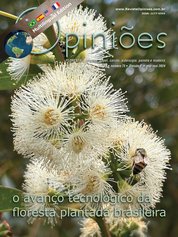André Dezanet
General Manager of Vallourec Florestal
OpCP75
State of the art technologies
A few days ago I came across the proceedings of the Forest Harvest Meeting that I participated in Curitiba, organized by Professor Malinovski in 2006. The leaves were already a little yellow, perhaps due to the heat that intensifies every year in Curvelo, but with content that it presented the most advanced technologies in forestry practices.
I am referring here to the recent past, but, leafing through this book, I confess that my memory betrayed me. I was surprised by what I saw and ended up placing the book on the table. For a moment I realized how time had past. It was as if I were looking at that ¬childhood photo, that portrait next to my parents, all with smiles on their faces, satisfied with having bought the family's first car, the Volkswagen Brasília, a symbol of robustness and comfort of an era.
Faced with the challenges of each era, technology reflects the human capacity to use knowledge and creativity to transform the world around us. The forestry area is witness to this, as the technologies developed in the sector have responded to a series of emerging challenges. The state of the art of these technologies reflects not only what is known and widely accepted, but the latest innovations, most advanced developments and trends. Below, I bring a non-exhaustive list of technological advances that are positively impacting the forestry sector:
1. Remote sensing and geographic information systems: have allowed detailed mapping and monitoring of forest resources. High spatial and temporal resolution satellite imagery, sensor-equipped drones and LiDAR provide valuable data on forest cover, health and change detection. They support forest planning and management decisions in optimizing planning activities and harvesting operations, carrying out forest inventory, pest control, fire monitoring, insight into biodiversity and carbon stock estimation.
2. Monitoring systems based on the Internet of Things: have been used for monitoring, management and conservation, providing early detection of problems and proactive management.
a) Strategically distributed intelligent sensors, which collect real-time data on environmental variables, such as temperature, air humidity, soil humidity, air quality and pollution levels;
b) infrared cameras and smoke detection systems, used to detect forest fires at an early stage;
c) camera traps and acoustic sensors, used to monitor biodiversity;
d) devices for monitoring tree growth, estimating wood volume and planning efficient transport routes.
3. Robotics and Automation: whether in the prototype phase or on a commercial scale, robotic applications have been applied in areas of environmental preservation and monitoring, fighting forest fires, inventory operations, planting and forest harvesting.
a) Autonomous forest harvesting: specialized robots that use advanced sensors such as cameras, LiDAR and GPS , to navigate the forest environment, identify trees, make precise cuts and process the wood for transport. They promise to increase efficiency, reduce costs and minimize the risks associated with manual work in high-risk environments.
b) Planting: robots being developed to automate the reforestation process, using computer vision systems and robotic arms to identify suitable locations for planting, carrying out digging and planting seedlings efficiently. Robotic planting can significantly increase the speed and scale of operations, filling gaps in labor-scarce locations.
4. Biotechnology and genetics: classical genetic improvement programs have been revisited in addition to allowing the development of more productive and disease-resistant trees, enhancing the development of clones with expression of desirable physicochemical characteristics, and above all, materials more adapted to climate changes. In parallel, advances in genetic engineering and breeding technologies through marker-assisted selection and genome editing techniques have been developed as platforms to accelerate specific demands for results.
5. Biomaterials and bioproducts: research and development of biomaterials and bioproducts Derived from forest resources are opportunities for product diversification and adding value to forest biomass in its entirety. This includes products such as bioenergy, bioplastics, renewable chemicals and bio-oil, all of which contribute to reducing greenhouse gas emissions as an alternative to fossil fuels.
6. Emerging technologies: Artificial Intelligence, machine learning and blockchain offer new opportunities for predictive modeling and decision support.
a) Artificial Intelligence algorithms play a central role in process optimization. By analyzing large sets of data, Artificial Intelligence identifies operational patterns, optimizing resource allocation, logistics and reforestation strategies.
b) Augmented reality applications in the training of forestry professionals through practical training in a virtual environment, enabling teams to face complex situations, simulating management strategies and promoting safety at work.
c) Blockchain for traceability in the supply chain through smart contracts. It allows product traceability, mitigating risks of illegal activities and ensuring that forest management complies with environmental and regulatory standards.
Technologies continue to be tools to face classic challenges in the sector, such as forestry productivity and rising production costs. Eucalyptus forests in Brazil, which despite showing increasing results in recent years, presented in 2022, according to the Brazilian Tree Industry, the lowest result in 9 years, estimated at 32.7 cubic meters per hectare per year (with bark at 6.7 years). Inflationary pressure also continues to be present. Also according to the Brazilian Tree Industry, the cost of wood production increased by 9% in 2022, already significantly lower when compared to 2021 (24%), but still well above the Broad National Consumer Price Index recorded in the same year (5.88%).
On the other hand, new challenges present themselves every day. Climate change and adaptations to environmental, social and corporate governance agendas have predominantly influenced the dynamics of technological developments. Previously marginal concerns are beginning to impose themselves on the agendas of the Research and Development teams of companies, startups and research and development institutions.
Technological innovation has been transforming the forestry sector, increasing productivity and resilience in forest management practices. By embracing these advances and promoting innovation, the forestry sector will continue to adapt to evolving challenges and contribute to an even more sustainable future.




